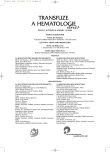B-cell chronic lymphocytic leukaemia
Authors:
T. Papajík; M. Jarošová; R. Plachý; K. Indrák
Authors‘ workplace:
Hemato-onkologická klinika FN a LF UP v Olomouci
Published in:
Transfuze Hematol. dnes,12, 2006, No. 2, p. 53-61.
Category:
Comprehensive Reports, Original Papers, Case Reports
Overview
Part I:
View of cell origin, biology and genomic changes of leukaemic clone B-cell chronic lymphocytic leukaemia represents most common leukaemia in everyday praxis of internists and haematologists. New findings about tumour cell biology, lymphomagenesis research and description of different IgVH genes mutational status allow us to view the chronic lymphocytic leukaemia as a biologically heterogeneous disease with minimally two distinct subtypes arising from antigen-experienced mature B-lymphocyte. Detailed analysis of genetic aberrations, gene expression levels, cell proteins and surface antigens, understanding of tumour cells – bone marrow and lymphatic organs microenvironment interactions can reveal high-risk and poor prognosis patients in early disease phase and contribute to development of more effective and targeted therapy of B-cell chronic lymphocytic leukaemia in near future.
Key words:
B-cell chronic lymphocytic leukaemia, lymphomagenesis, IgVH mutation, genetic changes
Labels
Haematology Internal medicine Clinical oncologyArticle was published in
Transfusion and Haematology Today

2006 Issue 2
Most read in this issue
- Chronic idiopathic myelofibrosis: biological characterization and histological “grading” of the fibrosis with respect to diagnosis and prognosis
- Anagrelide in the treatment of thrombocytosis in myeloproliferative disease – case report
- Hemorrhagic complications during warfarin therapy
- Idiopathic thrombocytopenic purpura in pregnancy refractory to immunosuppressive treatment – case report
